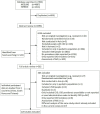Prevalence of chronic kidney disease in Asia: a systematic review and analysis
- PMID: 35078812
- PMCID: PMC8796212
- DOI: 10.1136/bmjgh-2021-007525
Prevalence of chronic kidney disease in Asia: a systematic review and analysis
Abstract
Introduction: The burden of chronic kidney disease (CKD) is growing rapidly around the world. However, there is limited information on the overall regional prevalence of CKD, as well as the variations in national prevalence within Asia. We aimed to consolidate available data and quantify estimates of the CKD burden in this region.
Methods: We systematically searched MEDLINE, Embase and Google Scholar for observational studies and contacted national experts to estimate CKD prevalence in countries of Asia (Eastern, Southern and South Eastern Asia). CKD was defined as estimated glomerular filtration rate (eGFR) <60 mL/min/1.73 m2 or the presence of proteinuria. For countries without reported data, we estimated CKD prevalence using agglomerative average-linkage hierarchical clustering, based on country-level risk factors and random effects meta-analysis within clusters. Published CKD prevalence data were obtained for 16 countries (of the 26 countries in the region) and estimates were made for 10 countries.
Results: There was substantial variation in overall and advanced (eGFR <30 mL/min/1.73 m2) CKD prevalence (range: 7.0%-34.3% and 0.1%-17.0%, respectively). Up to an estimated 434.3 million (95% CI 350.2 to 519.7) adults have CKD in Asia, including up to 65.6 million (95% CI 42.2 to 94.9) who have advanced CKD. The greatest number of adults living with CKD were in China (up to 159.8 million, 95% CI 146.6 to 174.1) and India (up to 140.2 million, 95% CI 110.7 to 169.7), collectively having 69.1% of the total number of adults with CKD in the region.
Conclusion: The large number of people with CKD, and the substantial number with advanced CKD, show the need for urgent collaborative action in Asia to prevent and manage CKD and its complications.
Keywords: epidemiology; public health; systematic review.
© Author(s) (or their employer(s)) 2022. Re-use permitted under CC BY-NC. No commercial re-use. See rights and permissions. Published by BMJ.
Conflict of interest statement
Competing interests: TL, TT and KP have no relevant conflicts of interests to declare. MW declares consulting work for Amgen, Kyowa Kirin and Freeline, and was funded by an Australian National Health and Medical Research Council Investigator and Programme Grants. VP reports receiving personal fees for Advisory Boards or Scientific Presentations from Retrophin, Janssen, Merck, and Servier. VP also reports receiving fees for Advisory Boards, Steering Committee roles, or Scientific Presentations from Abbvie, Astellas, Astra Zeneca, Bayer, Baxter, BMS, Boehringer Ingelheim, Dimerix, Durect, Eli Lilly, Gilead, GSK, Janssen, Merck, Mitsubishi Tanabe, Novartis, Novo Nordisk, Pfizer, Pharmalink, Relypsa, Retrophin, Sanofi, Servier, Vifor and Tricida. HS-F was a full-time employee and shareholder of GlaxoSmithKline. VJ reports grant funding from NephroPlus, Baxter Healthcare and GSK and speaker fees and honoraria from Baxter Healthcare and AstraZeneca (all monies paid to the employing organisation). MJ reports receiving research support from (1) the Australian National Health and Medical Research Council and (2) VentureWise (a wholly-owned subsidiary of NPS MedicineWise) to conduct a project funded by AstraZeneca.
Figures
Comment in
-
Comparison of benzbromarone and allopurinol on the risk of chronic kidney disease in people with asymptomatic hyperuricemia.Eur J Intern Med. 2023 Jul;113:91-97. doi: 10.1016/j.ejim.2023.04.025. Epub 2023 Apr 29. Eur J Intern Med. 2023. PMID: 37127506
References
-
- United States Renal Data System - 2012 Atlas of CKD & ESRD 2012.
Publication types
MeSH terms
LinkOut - more resources
Full Text Sources
Medical
Research Materials
Miscellaneous

